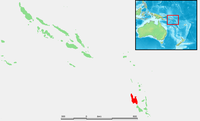Coconut War
| Coconut War | |||||||
|---|---|---|---|---|---|---|---|
 Map of Espiritu Santo inside Vanuatu | |||||||
| |||||||
| Belligerents | |||||||
|
|
Support: Phoenix Foundation | ||||||
| Commanders and leaders | |||||||
|
Sir Peter Kenilorea |
Support: | ||||||
The Coconut War was a brief clash between
Background
Prior to Vanuatu's independence, the islands were known as the New Hebrides. The New Hebrides were governed by a condominium of France and the United Kingdom. In 1980, France and the United Kingdom agreed that Vanuatu would be granted independence on 30 July 1980.
Beginning in June 1980,
Confrontation
On 8 June 1980, the New Hebrides government asked Britain and France to send troops to put down a rebellion on the island of Espiritu Santo.[6] France and Britain sent troops but the French refused to allow them to take any effective action against the rebels. As independence day neared, the Prime Minister-elect, Walter Lini,[7] asked Papua New Guinea if it would send troops to intervene.[1] As Papua New Guinean soldiers began arriving in Espiritu Santo,[8] the foreign press began referring to the ongoing events as the "Coconut War".
However, the "war" was brief and unconventional. The residents of Espiritu Santo generally welcomed the Papua New Guineans as fellow
At Stevens's trial, the support of the Phoenix Foundation to the Nagriamel movement was revealed. It was also revealed that the French government had secretly supported Stevens in his efforts. Stevens was sentenced[2] to 14 years' imprisonment; he remained in prison until 1991.
Notes
- ^ a b Michael T. Kaufman (23 February 1999). "Walter Lini, 57, Clergyman Who Led Nation of Vanuatu". The New York Times. Archived from the original on 18 January 2023. Retrieved 18 September 2009.
- ^ a b "South Pacific Rebel Seized". The New York Times via Reuters. 14 September 1982. Archived from the original on 24 May 2022. Retrieved 18 September 2009.
- ^ "Pacific Islands in Election Battle". The New York Times. 1 November 1983. Archived from the original on 18 January 2023. Retrieved 18 September 2009.
- ^ William Borders (12 June 1980). "British Answering New Hebrides Call; Company of Marines Being Sent 'to Provide Stability' French Antiriot Police Arrive Threat to Independence One Killed on 2d Island 55 French Riot Police Land". The New York Times. Archived from the original on 18 January 2023. Retrieved 18 September 2009.
- ^ Treaster, Joseph B. (7 June 1980). "U.S. Land Developer Aids New Hebrides Dissidents". The New York Times. Archived from the original on 18 January 2023. Retrieved 18 September 2009.
- ^ "New Hebrides Asks for Aid in Revolt; Plea Might Go to U.N." The New York Times. 8 June 1980. Archived from the original on 18 January 2023. Retrieved 18 September 2009.
- ^ Bernard D. Nossiter (9 July 1981). "Vanuatu, New Pacific Nation, Moving Toward Seat at U.N." The New York Times. Archived from the original on 18 January 2023. Retrieved 18 September 2009.
- ^ Graeme Dobell (26 June 2003). "Alexander Downer announces moves toward a new foreign policy – Transcript". PM. Archived from the original on 18 January 2023. Retrieved 17 September 2009.
- ^ "Rebel Radio on Santo". Vanuatu Daily Post. 7 August 2020. Archived from the original on 18 January 2023. Retrieved 23 October 2020.
- ^ "New Hebrides Rebel Urges Peace; Willing to Fight British and French One British Officer Injured". The New York Times. 9 June 1980. Archived from the original on 18 January 2023. Retrieved 18 September 2009.
References
- Richard Shears (1980). The Coconut War: The Crisis on Espiritu Santo (Cassel: North Ryde, NSW ISBN 0-7269-7866-3)
- Andrew Stewart (2001). Of Cargoes, Colonies and Kings: Diplomatic and Administrative Service from Africa to the Pacific (I. B. Tauris: London ISBN 1-86064-713-8) pp. 214–224
- "A Memory of the Coconut War: Rebel Leader Jimmy Stevens Freed", The Economist, 31 August 1991
Contemporary newspaper reports
- "New Hebrides Calling for Help to Put Down Rebellion", The New York Times, 31 May 1980, p. 11
- "Separatists Threaten Hebrides Unity", The New York Times, 8 June 1980, p. E2
- "New Hebrides Asks for Aid in Revolt; Plea Might Go to U.N.", The New York Times, 8 June 1980, p. 12
- "Unrest Spreads in New Hebrides", The New York Times, 11 June 1980, p. A8
- "British Answering New Hebrides Call; Company of Marines Being Sent 'to Provide Stability'", The New York Times, 12 June 1980, p. A5
- "British-French Control Ends in New Hebrides, Now Named Vanuatu", The New York Times, 30 July 1980, p. 11
- "Rebels Blow Up 2 Bridges on Island of Espiritu Santo", The New York Times, 4 August 1980, p. A5
- "40 Are Seized on Espiritu Santu in a Drive Against Secessionists", The New York Times, 4 August 1980, p. B8
- "55 French Are Evacuated From Espiritu Santo Island", The New York Times, 18 August 1980, p. A5
- "Leader of Espiritu Santo Rebels Says That He'll Surrender Today", The New York Times, 29 August 1980, p. 3
- "Troops Reportedly Crush Rebellion on Espiritu Santo", The New York Times, 1 September 1980, p. A5
External links
- Vanuatu: History: Independence, Vanuatu Tourism Office, 2009
- Franky Stevens's interview about Vanuatu independence history
